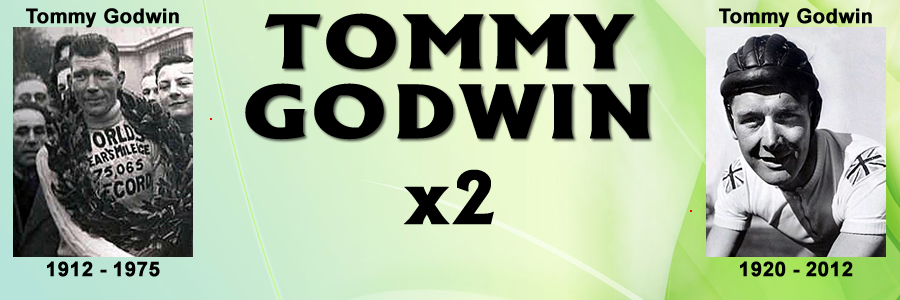We sadly lost one of the great legends of cycling earlier this month…
Thomas Charles Godwin (5 Nov 1920 – 3 Nov 2012), was a British track cyclist, active during the 1940s and 1950s. He held national records, raced abroad and was an Olympic Medallist. He later became a coach, manager, and administrator.
In 2010 he was selected as an ambassador for the 2012 London Olympics; and in 2012, aged 91, he was selected to take part in the Olympic torch relay, carrying it through Solihull.
However, there was another Tommy Godwin – also a great cyclist and a Record Holder.
Thomas Edward Godwin (1912–1975) was also an English cyclist who held the world cycling record for most miles covered in a year (75,065 miles or 120,805 kilometres) and the fastest completion of 100,000 mi (160,000 km).
In 1939, Godwin entered the Golden Book of Cycling as the greatest long-distance rider in the world.
He rode 75,065 mi (120,805 km) in 1939, averaging over 200 miles (320 km) per day. This record stood for 77 years, until 2016.
===============================================================================================
Tommy Godwin – Long Distance Record Holder was born in Stoke on Trent.
To help support his family he worked as a delivery boy for a greengrocer and with the job came a heavy bike with metal basket. The basket was hacked off and the 14-year-old Godwin won his first 25-mile (40 km) time trial in 65 minutes.
After his initial time trial success, he subsequently clocked inside 1 hour 2 minutes for 25 miles on four occasions, and covered 236 miles in 12 hours.
Godwin left his amateur status at Potteries CC to join Rickmansworth Cycling Club as a professional. After more than 200 road and time trial wins, the mileage record beckoned.
In 1911 the weekly magazine Cycling began a competition for the highest number of 100-mile rides or “centuries” in a single year. The winner was Marcel Planes with 332 centuries in which he covered 34,366 miles (55,307 km).
The inspiration for the competition was said to be the efforts of Harry Long, a commercial traveller who rode a bicycle on his rounds covering every part of England and Scotland and who covered 25,376 miles (40,839 km) in 1910.
The record was officially established nine times up to 1939.
In January 2016 Godwin’s very long-standing record was broken. The American Kurt Searvogel completed 76,076 miles (122,432 km) in one year, confirmed by the Ultramarathon Cycling Association, and this was later also recognised by the Guinness Book of Records.
Tommy Godwin – Track Cyclist, was born in Connecticut, United States to British parents in 1920. The family returned to Britain in 1932.
His first bicycle was a Wrenson’s delivery bike which he used to run errands for a local grocer. He became interested in cycling because of the 1936 Summer Olympics.
Godwin began racing three years later and rode the fastest 1,000m of the season at the Alexander Sports Ground. He was invited to trials in the Midlands to find riders for the next Olympics, despite not yet having won a race.
He won a 1,000m at The Butts track in Coventry on 29 July 1939. His chances of Olympic selection ended with the second world war.
He envied Reg Harris and Dave Ricketts for being selected for the world championship at a young age, “not that I had any claims to such honours but because their good fortune provided them with expert tuition and decent tracks for training. In the Midlands, this all seemed so far away.”
Godwin was an apprentice electrician in a reserved occupation during the war, working for BSA. But there was little competitive cycling and he rode at only 13 meetings between 1940 and the end of 1942.
The change in war fortunes meant more sport in Britain from 1943. Godwin was unbeaten in five-mile scratch events and won the Cattlow Trophy at Fallowfield, Manchester, that year and in 1944.
In the national championship of 1944, at which Harris made his breakthrough, Godwin won the five-mile. He repeated this success in 1945, adding the 25-mile title which he retained in 1946.
In 1949 he won the 4000 metres event. He won the BSA Gold Column, offered by his employers, by winning the five-mile at Herne Hill in south London in 1945.
At the 1948 Summer Olympics in London, Godwin won two bronze medals, in the team pursuit, with Robert Geldard, Dave Ricketts, and Wilfrid Waters, and in the 1,000m time trial. Preparation for the pursuit was hampered by an argument among the coaching staff on the eve of the games, but after a poor performance in the qualifying round, they improved their time by 17 seconds in the subsequent three rounds, winning the bronze in a time faster than the French achieved in the final.
He came third in the 1,000m at the 1950 British Empire Games.
Godwin managed the British cycling team at the 1964 Summer Olympics in Tokyo, became president of the British Cycling Federation and the Solihull Cycling Club.
He was Britain’s first paid national coach and trained a generation of British track riders, many of whom won national and international titles and medals.
From 1936 to 1950, he worked for BSA and from 1950, he ran a cycle shop in Kings Heath, Birmingham.
His autobiography It Wasn’t That Easy: The Tommy Godwin Story was published in 2007 by John Pinkerton Memorial Publishing Fund.
Godwin died at the Marie Curie Hospice in Solihull on 3 November 2012.

